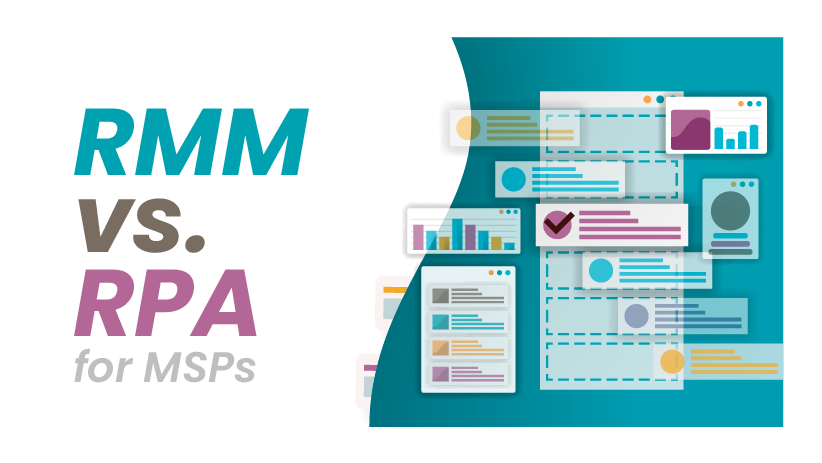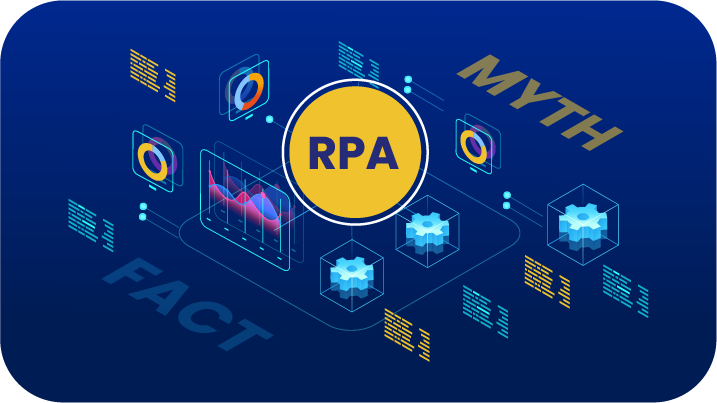RMM vs. RPA for MSPs: Why you need to think bigger
Discover why RMM alone isn't enough. Learn how RPA for MSPs drives full-process automation, enhances efficiency, and unlocks greater business value

Famous business consultant and author Peter Drucker once said, “Efficiency is doing things right; effectiveness is doing the right things."
As an MSP, how you approach automation directly affects your operational efficiency and service quality. Automation isn’t just about doing things faster; it’s about ensuring every task contributes to a more extensive, effective, and consistent business process.
The first part of our automation series addresses the misconception that using endpoint-focused tools like RMMs fully automates your MSP. While these tools are foundational, relying on them alone means your MSP misses opportunities to leverage the capabilities of robotic process automation (RPA). True automation unlocks its full potential by eliminating human error and automating repetitive tasks across your entire business process.
In this follow-up, we’ll explore the three tiers of automation and show how a full-process approach enables you to tackle the complex, interconnected tasks required by today’s MSPs. This improves service delivery and ensures your efforts align strategically with broader business goals. Lastly, we’ll explain how to establish an Automation Center of Excellence to help you get the most out of your automation strategy and drive sustained success.
What are the three tiers of automation?
Tier 1: RMM integrations—The starting point
Most MSPs begin their automation journey with their RMM, a tool essential for managing endpoints, servers, and IT infrastructure. RMM platforms enable single-task automation like patching and monitoring systems, saving routine IT support functions time. However, as your MSP scales and client demands grow, you’ll find that an RMM alone isn’t enough to handle more complex data entry tasks or broader business processes.
The primary pitfall with RMM-based automation is its narrow focus on endpoint monitoring and alerts. Rewst Automation Developer, Greggory Horn explains, “RMMs handles single tasks well, but as soon as you try to scale or manage systems beyond endpoints—like network devices or cloud applications—you run into limitations.” An RMM can only perform as far as its scope allows, leaving MSPs stuck in a cycle of reactive alerts and manual interventions when tasks exceed the RMM’s built-in capabilities.
For example, Rewst Lead Automation Specialist Ben Climer used to work for an MSP that used Continuum (now ConnectWise RMM) to send after-hours technician alerts via Twilio.
The problem?
ConnectWise RMM couldn’t prioritize these alerts. Technicians received every alert—regardless of its importance to inefficiencies and notification fatigue. This is a common frustration for MSPs relying solely on RMMs to automate tasks: they get overwhelmed with notifications but still lack the ability to automate more extensive business processes.
Tier 2: Manual API–based platforms—Expanding capabilities
When MSPs realize that RMMs are too limited to handle the increasing complexity of their operations, they often turn to manual API-based automation platforms like Zapier or Microsoft Power Automate. These tools allow for more flexible integrations and work with existing RMMS toward multi-step automations. However, while manual API configuration expands your capabilities, it comes with its own set of challenges.
Two significant pitfalls of manual API configuration are its dependency on underlying systems and the resources needed to maintain those systems. As Ben experienced, “At one point, we had automations set up between Zapier, Power Automate, and Twilio for after-hours alerts. Everything worked until one day, an API changed, and suddenly, our whole setup broke. Fixing it was a time-consuming, mundane task-well over a day’s work.”
This illustrates a critical drawback: even though API-based tools allow for more complex automations, they require constant oversight and maintenance to keep up with evolving systems.
Additionally, these tools often create isolated workflows that don’t connect smoothly with each other. Greggory Horn shared an example where his previous MSP needed to manage multiple systems: RMM for endpoints, LogicMonitor for network devices, and another tool for application clusters. “We ran several PowerShell scripts to make API calls between tools, but the number of failure points was staggering.”
This disjointed nature creates scalability issues and increases the risk of failures as you add more layers. Maintaining the connections between systems requires an ever-increasing investment in time and resources. It also limits the potential for true process automation because these tools often focus on repetitive, rule-based tasks or workflows, not the bigger picture.
Automation should be more than just running scripts or monitoring systems—it should fundamentally transform your business. This means going beyond simple task automation and focusing on building workflows that deliver real, measurable value to your clients.- Rewst Founder and CEO, Aharon Chernin
Tier 3: Full-process MSP RPA— Moving beyond the basics
While your RMM or API has been the cornerstone of automation efforts, it’s time to think bigger. The future goes beyond the ability to automate repetitive rule-based tasks and towards end-to-end processes that span multiple systems and deliver more significant value like increased MRR, cost savings, and technician job satisfaction. While RMM and API house tools that help you get there, they are only a step in the direction of MSP robotic process automation.
Imagine integrating your entire tech stack onto a canvas that delivers unified and automated workflows; that’s full process automation. Brian Simpson, Integration and Automation Specialist at Karpel Solutions, describes one example of how integrating his tech stack into full-process RPA, Rewst empowered his MSP:
“Rewst seamlessly integrates with all our existing tools like ConnectWise Manage and our DevOps dashboards, synchronizing alerts and tickets across teams and eliminating data silos within our MSP. By automating our end-to-end processes, we save an average of 437 hours per week, enabling us to operate more efficiently and deliver even greater value to our clients.”
Read the complete Karpel Solutions case study here.
Unlike API-based automation that requires manual intervention when APIs change, full-process automation offers MSPs built-in adaptability. Platforms like Rewst offer prebuilt, customizable workflows packaged as “Crates” and integrations that come with regular updates. Updates keep automations running smoothly even as the underlying systems evolve. You no longer have to worry about your automation breaking when an API changes—Rewst takes care of that.
Another significant advantage of full-process automation is its ability to automate an MSP’s technical and operational side. For example, Rewst can automate an entire onboarding process, from setting up user accounts to generating tickets for the finance team. Greggory Horn elaborated: “We created a workflow that handles the technical onboarding, then automatically generates tickets for accounting to update billing. It even triggers a conversation with the vCIO if the client needs a service tier upgrade.” Imagine reducing manual errors, optimizing infrastructure, and improving billing reconciliation in one sweep.
Traditional RMM and manual API configurations often lack automation technologies needed to make broader business decisions. Full process automation platforms like Rewst can integrate two disparate platforms like HubSspot with ConnectWise PSA enabling MSP sales teams to manage performance data and make proactive forecasting decisions.
Trying to achieve the same level of automation with tools like Zapier or Power Automate would require significant custom development and ongoing maintenance—something that many MSPs don’t have the resources to manage.
How to create an Automation Center of Excellence
Now that you understand what full-process automation can do for you, how do you get started? Transitioning from traditional RMM and API-based endeavors to full-process automation requires a strategic, thoughtful approach. This is where establishing an Automation Center of Excellence (CoE) comes into play.
A CoE serves as the driving force behind optimizing RPA implementation, ensuring that automation efforts align with your broader business goals and implement in a way that delivers maximum value.
Here’s how you can set up your own Automation Center of Excellence:
- Executive Champion: You’ll need strong leadership to push automation efforts forward. Identify an executive champion—someone at the top who understands the value of automation and is committed to making it a priority across the organization.
- Automation Champion: This person will serve as your internal advocate for automation. They don’t need to be a technical expert, but they should understand the operational challenges of your MSP. Their job is to identify where automation can have the most impact
- Automation Engineer: You’ll need skilled automation engineers to build and maintain automations. However, their work must meet the business’s needs, not just technical possibilities.
Your automation champion finds the problems, the executive champion prioritizes them, and the automation engineer builds the solutions. A well-established CoE is the key to sustaining and growing your automation strategy. It ensures your MSP doesn’t just automate for the sake of automation but creates impactful, scalable workflows that provide long-term value.
The path forward
The future of MSP operations lies in full-process automation, which goes far beyond the capabilities of RMMs and API-based tools. By adopting platforms like Rewst, you can achieve higher levels of efficiency, reduce automation failures, and deliver more value to your clients. Now is the time to move beyond task-based automation and strategically embrace the full spectrum of possibilities through an Automation Center of Excellence.
Latest Blog Posts
Subscribe to Our Blog
Stay up to date with the latest on our platform, automation, events and news.
We're committed to your privacy. Rewst uses the information you provide to us to contact you about our relevant content, products, and services. You may unsubscribe from these communications at any time.









